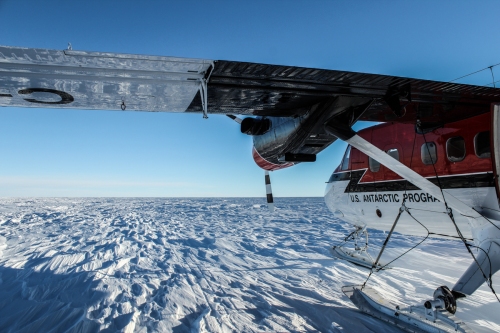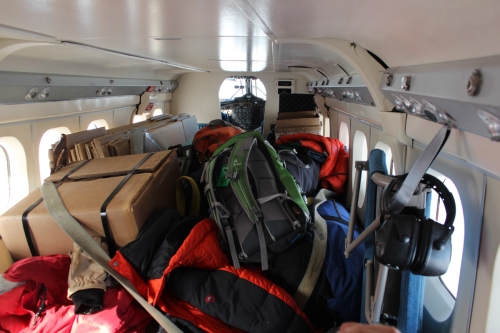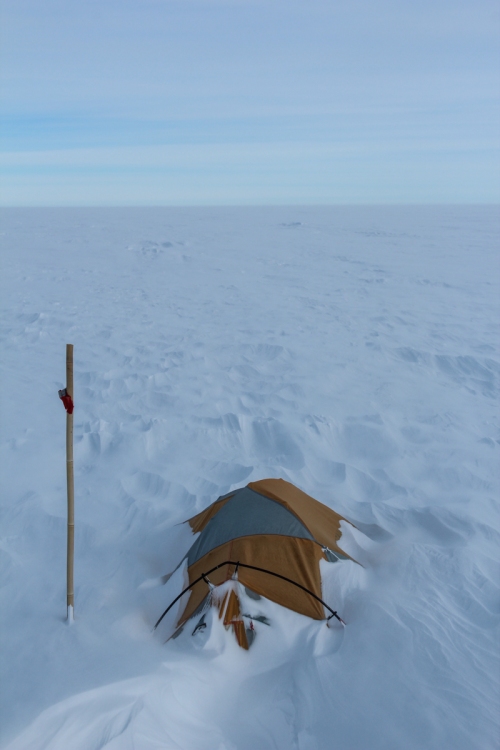 The WAS Recovery Team has returned victorious and with smiles on our faces yet! To quote our project manager announcing the successes of the season: “…The Pine Island Glacier (PIG) Traverse arrived back at WAIS Divide field camp yesterday afternoon, Sunday January 25th NZDT, completing the full return of ~ 90,000 pounds of camp infrastructure and equipment from the PIG C site. The excavation of the buried equipment and cargo by the 4-person recovery team prior to the arrival of the traverse proved critical to the success of this effort.” We had a great season in the field, making it to all three sites: PIG, WAIS, and Byrd. We had no internet access out there, only an HF radio and two iridium phones. So let me start at the beginning… On November 19, after several weather delays, we finally boarded a LC-130 Herc and departed McMurdo for WAIS Divide. The first day at WAIS was spent digging out the PIG Traverse berm and sorting our cargo into first and second flight loads for the Twin Otter. We put-in at PIG on the 21st with the Twin Otter making two trips – first with some of our cargo and then a second flight with the four of us and more of our survival supplies.
The WAS Recovery Team has returned victorious and with smiles on our faces yet! To quote our project manager announcing the successes of the season: “…The Pine Island Glacier (PIG) Traverse arrived back at WAIS Divide field camp yesterday afternoon, Sunday January 25th NZDT, completing the full return of ~ 90,000 pounds of camp infrastructure and equipment from the PIG C site. The excavation of the buried equipment and cargo by the 4-person recovery team prior to the arrival of the traverse proved critical to the success of this effort.” We had a great season in the field, making it to all three sites: PIG, WAIS, and Byrd. We had no internet access out there, only an HF radio and two iridium phones. So let me start at the beginning… On November 19, after several weather delays, we finally boarded a LC-130 Herc and departed McMurdo for WAIS Divide. The first day at WAIS was spent digging out the PIG Traverse berm and sorting our cargo into first and second flight loads for the Twin Otter. We put-in at PIG on the 21st with the Twin Otter making two trips – first with some of our cargo and then a second flight with the four of us and more of our survival supplies.
 A deep field put-in requires shelter, comms, and a heat source before the plane is allowed to leave. We had delegated tasking beforehand and the Scott tent was erected right away, McMurdo Operations (MacOps) was called on the Iridium phone, and our little whisper-lite stove was fired up to prove we could melt snow for water. The Twin Otter pilots said their good byes and headed back to WAIS. Thankfully it was a calm and beautiful evening and we spent the next few hours settling in. I dug an outhouse trench and set up a little tent over it. Andy, our mechanic, got busy digging out and setting up the Nordic diesel drip stove which was wonderfully right at the surface of the snow on the PIG berm. DeVal, our camp manager, and Jen, the field coordinator, quickly excavated some proper floor panels from the berm and began shaving down a level area where we could set up the larger more comfortable Arctic Chief tent. Scott tents are great shelter – they are sturdy, but there isn’t much insulation and they’re quite small for a primary shelter.
A deep field put-in requires shelter, comms, and a heat source before the plane is allowed to leave. We had delegated tasking beforehand and the Scott tent was erected right away, McMurdo Operations (MacOps) was called on the Iridium phone, and our little whisper-lite stove was fired up to prove we could melt snow for water. The Twin Otter pilots said their good byes and headed back to WAIS. Thankfully it was a calm and beautiful evening and we spent the next few hours settling in. I dug an outhouse trench and set up a little tent over it. Andy, our mechanic, got busy digging out and setting up the Nordic diesel drip stove which was wonderfully right at the surface of the snow on the PIG berm. DeVal, our camp manager, and Jen, the field coordinator, quickly excavated some proper floor panels from the berm and began shaving down a level area where we could set up the larger more comfortable Arctic Chief tent. Scott tents are great shelter – they are sturdy, but there isn’t much insulation and they’re quite small for a primary shelter.
By midnight that first night we had the Scott tent and the Arctic Chief up with the Nordic stove burning and a big pot of snow on top to melt. We sat in a circle and ate our dehydrated dinner packets then rolled out our sleeping bags and slept side by side on the floor. The next day we set up our individual mountain tents (Mountain Hardwear Trango’s) and unpacked and organized the rest of our food and cargo. Then it was time to get down to business…
Pine Island Glacier is located near the coast of West Antarctica – from the air you can just see a dark line that is the ocean and on a clear day on the ground you can see two little mountains peaking over the horizon. For the most part though it is flat white with awful weather, even by West Antarctic standards. Being so close to the ocean we were visited by a few South Polar Skuas and Snow Petrels! This area gets significant accumulation and it had been two years since the camp was closed and the cargo bermed. The satellite photo I posted earlier showed the cargo lines fairly clearly which was encouraging and some pallets were quite scoured. The Tucker however, was almost completely gone, with just a few inches showing above the surface!
We marked out the area to be cleared and fired up the chainsaws. The snow there is heavy and hard, more like sandstone than snow at times! Shovels worked great for the first half meter and for cleaning up edges and the bits thrown out by the chainsaws, but the chainsaws were really the star of the show. And the pick axes. The blocks were heavy too, the snow being about 50% water. Blocks were cut, heaved to the lip of the pit, and then loaded onto little sleds and dragged out of the way downwind. We did this in part to keep the working area around the pit clear and also to reduce drifting as we would eventually have to dig up buried items on either side of the Tucker as well. It took 5 days to fully clear the Tucker; to excavate around and under the vehicle, chip out the ice in the tracks, and melt out the engine and cab. And then we connected the battery and…it fired right up without a hitch and I drove it out of the hole! 
On November 28 we celebrated Thanksgiving, sleeping in and indulging in frozen corn and stuffing mix. With perfect timing the weather closed in and for the next two days we were stuck inside as the storm raged – filling in the giant Tucker hole we had just cleared. Then we started digging out the Cat 297 and fuel tank following the same process as the Tucker. 4 days later we drove that out of the ground and got to work digging out the other pallets of cargo. Just a few days after that we were hit again with another storm. And so it went…digging, sawing, and chipping out pallets of cargo, then when we’d reached a good stopping point a storm would roll through and we’d hunker down in the Chief. Old Star Trek movies proved to be a good source of entertainment and conversation.
Meanwhile, back at WAIS the PIG Traverse was working hard to get their sleds and tractors together and in working order. This far from McMurdo all fuel is brought in via LC-130s. Delays and cancellations meant that the WAIS Divide camp was low on fuel itself with none to spare for the traverse. So the PIG Traverse had to make a trip out to Byrd to fill their fuel bladders and on December 17th they finally headed our way. It was perfect timing, delays and all – On the 20th we unearthed our final piece, the groomer. We had been dreading this skeleton of metal, which would be rocked in hard with ice and snow. Big square things were easy to pull out, but something with so much open space meant we’d have to clear it out completely.
It was completely buried. If we didn’t have a photo of the berm before they’d left in Jan 2013 we’d never have known it was there at all! Only a flag marking the tip of the hitch was visible. Thankfully with a little help from our friend, the Tucker, and some chainsaw work it came out smooth as butter in just one day! We were done – all cargo excavated, ready and waiting for the Traverse to arrive.
As soon as we were done, with impeccable timing, the biggest storm yet closed in on us. We huddled inside the Chief for nearly 4 days waiting it out as it dumped snow and howled at 25-30kts. We read, and slept, made breakfast for dinner with some dehy hash browns and frozen eggs and watched movies on the little laptop – powering it via a little 1KW generator when the clouds were too thick for the solar panels to work. With the sun up 24/7 we had little need for electricity. A few light weight solar panels charged small electronics like our iridium phones, camera batteries, and kindles, but we had brought along a 1KW portable generator as well.
The Traverse arrived late in the day on Christmas Eve bearing mail and baked goods from WAIS. The 9 of us crammed into the Arctic Chief for a special Christmas dinner and good times were had by all as we shared stories of the prior month and cracked open a few cans of egg nog.
Andy’s contract was up at the end of December so the Twin Otter picked him up the day after Christmas – and we set to work digging out all the cargo for a second time. That big storm had created whales of drifts that had engulfed not only our tents, but the cargo we had so carefully unearthed. With everyone helping we got the traverse loaded up and on Dec 28th they left PIG with the first load of ~15 pallets. We stayed busy organizing and palletizing the remaining cargo while they drove halfway to WAIS and staged the first load. They returned a few days later and on January 4th with a break in the weather we flew back to WAIS. Job complete.
We spent a week at WAIS Divide, enjoying the home cooked food and the larger camp facilities like the showers…After 6 weeks at PIG with only baby wipes I didn’t mind shoveling a bunch of snow for a shower! The Twin Otter pilots had taken some photos of the buried Tucker and the folks at WAIS were pretty awed. The next task was to fly out to Byrd camp to repair the Tucker and bring it back to WAIS so it could be utilized at other camps as needed. While we waited for two mechanics from McMurdo to join us, and then for a flight out to Byrd, we helped around camp. As an operator I mostly groomed and helped with the winter berms.  On Jan 12th we finally got good weather and permission to fly and it was off to Byrd. The berms at Byrd were the complete opposite from PIG, well scoured, still quite high above grade, and with much softer snow. We set up personal mountain tents to sleep in and opened up the hard sided galley module for cooking and as a DNF (do not freeze…aka heated) space. That week was spent digging out the Tucker, repairing it, verifying the fuel inventory, raising the skiway drags, and putting together a mini-traverse for the drive back to WAIS. Byrd and WAIS are only about 100 miles apart, but both sites are so remote and the environment so inhospitable that it could be very serious should anything go wrong. We loaded a piece of high molecular weight (HMW) plastic with survival supplies, the Scott tent, extra food, twice the amount of fuel they expected to use, backup iridium phones, and various other pieces of cargo to lighten the final Twin Otter flight. This ultra-slick material is the foundation for almost all Antarctic traverses these days. Then, on the morning of Jan 17th, one of the mechanics and our team lead departed Byrd for WAIS Divide. Thankfully the snow conditions were just right and the Tucker had no issues, and they sailed in to WAIS by the end of the day! The following morning the Twin Otter managed to fly out to Byrd and picked up the remaining three of us who had been left behind. We spent the final week at WAIS waiting for a flight to McMurdo and helping out around camp.
On Jan 12th we finally got good weather and permission to fly and it was off to Byrd. The berms at Byrd were the complete opposite from PIG, well scoured, still quite high above grade, and with much softer snow. We set up personal mountain tents to sleep in and opened up the hard sided galley module for cooking and as a DNF (do not freeze…aka heated) space. That week was spent digging out the Tucker, repairing it, verifying the fuel inventory, raising the skiway drags, and putting together a mini-traverse for the drive back to WAIS. Byrd and WAIS are only about 100 miles apart, but both sites are so remote and the environment so inhospitable that it could be very serious should anything go wrong. We loaded a piece of high molecular weight (HMW) plastic with survival supplies, the Scott tent, extra food, twice the amount of fuel they expected to use, backup iridium phones, and various other pieces of cargo to lighten the final Twin Otter flight. This ultra-slick material is the foundation for almost all Antarctic traverses these days. Then, on the morning of Jan 17th, one of the mechanics and our team lead departed Byrd for WAIS Divide. Thankfully the snow conditions were just right and the Tucker had no issues, and they sailed in to WAIS by the end of the day! The following morning the Twin Otter managed to fly out to Byrd and picked up the remaining three of us who had been left behind. We spent the final week at WAIS waiting for a flight to McMurdo and helping out around camp.
I’m back in McMurdo now, heading on to New Zealand shortly. The PIG Traverse just made it back to WAIS on Jan 25th successful in their final haul to bring the 90,000lbs of PIG cargo back. WISSARD, Siple, and WAIS Divide are in the process of shutting down. It’s been a great season with a great crew! I want to send a huge Thank You to all the McMurdo field support staff, the PIG Traverse guys, the Twin Otter crew, and the WAIS Divide camp staff!




































Thank you Very much for this comprehensive logbook. Must be quite a thing to stay so long in antarctica…and in such conditions.
Next stop: Christchurch and green grass!
Holy Freakin’ Wow. You just keep cranking up the badass-ometer, don’t you? Awesome trip report, and I’m humbled and intimidated by how casual you make all this incredible stuff seem. Folks back home seem impressed that I put in (one!) season at Pole, wearing fuzzy slippers and fixing computers as an indoor house pet. But you? Holy cow – you’re awesome. Many thanks for sharing the adventure with us!
-pablo
Haha Thanks Pablo!! Hope to see you back down someday 🙂
Fantastic adventures in a cold white world!
Pingback: Ice to Ice | AntarcticArctic